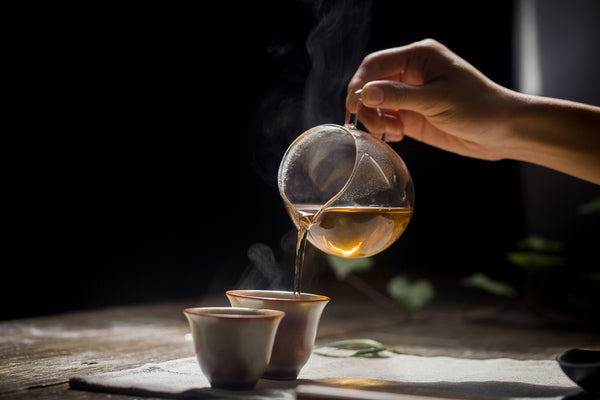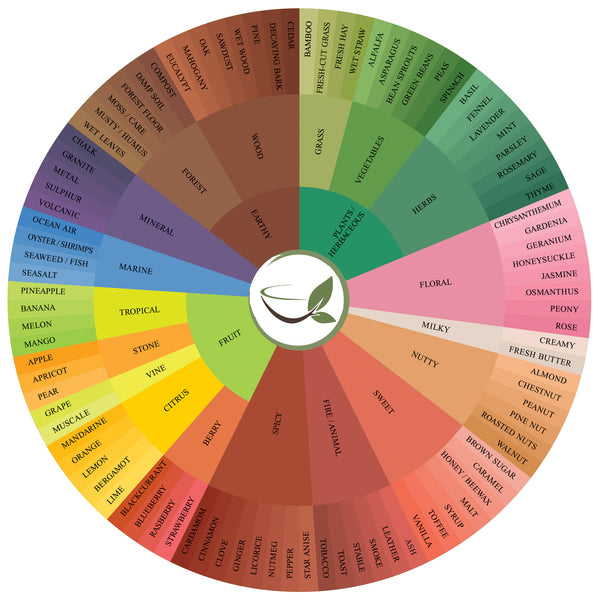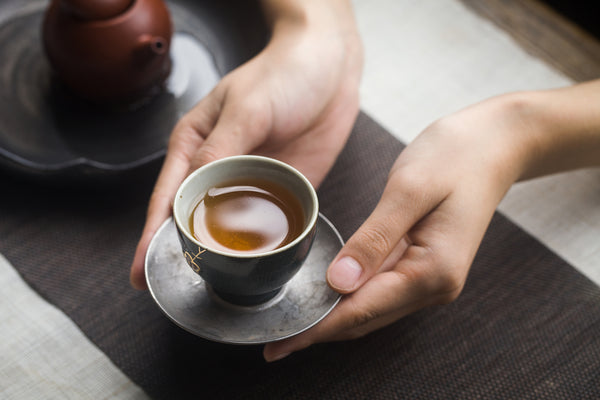"Full, thick body", "a robust, woody base with accentuated floral notes", "delightfully sweet aftertaste". You probably heard these coming from the tea crowd more often than not. If you're new to the world of tasting tea, it might seem like some high knowledge accessible only to a few selected. In case that sounds too complicated, we assure you that tea tasting and evaluation aren't reserved solely for the connoisseurs. Instead, it is a sensory experience for the most part, and much like the skilled work of wine sommeliers, it is approachable and enriching for every tea lover out there. Today's blog post delves into the art of tea tasting and appreciation. It's about unraveling the complexities and joys of evaluating tea. This practice is open and accessible to anyone who loves tea and wants to deepen their understanding of its many layers.
Together, we delve into the essential aspects of tea tasting that reveal each tea's true nature and character. By learning to pay attention to these key aspects, we enhance our sensory palette and elevate our appreciation and enjoyment of tea to new heights. Each focused tasting session is a step forward in fine tuning our abilities to recognize and savor the subtle nuances in our cups. So, let's embark on this enlightening journey and equip you with the knowledge to transform every sip into a deeper, more meaningful encounter with tea.
A Deep Dive into Tasting Tea: Exploring The Essential
Besides its unique character, each tea has some key features that are subject to (mostly) sensory analysis — like aroma, taste, mouthfeel, and more. By attuning ourselves to these elements, we go deeper into understanding the tea's nature and elevate our appreciation. Training our senses to distinguish the subtle nuances of tea doesn't happen overnight. Much like the expertise of wine sommeliers, it is a process that requires patience and dedication – yet it's completely accessible to the untrained palate. With each focused tasting session, we refine our ability to perceive and enjoy tea's flavors and textures. Here, we will guide you on the key aspects of the tea you should focus your attention on to elevate your tasting abilities, turning each sip into a more profound experience.
Here are the major tasting and evaluation aspects to watch out for when tasting tea:
Aroma
The initial and evolving scent of the tea, both dry and when infused. Aroma is a critical element in tea tasting that reveals much about the tea's character, processing methods, and freshness, among others. It marks our first encounter with tea, significantly enhancing its overall experience.
The aroma in tea varies widely - Green teas often offer fresh, grassy notes; Oolong teas might present a complex bouquet of floral, fruity, or roasted aromas; Black teas (Red Teas) can range from sweet and malty to spicy and chocolaty; while Shou Pu-erh and other dark teas might exude earthy, woody, or even musty notes.
How to evaluate aroma in tea tasting:
Begin by smelling the dry leaves to get an initial impression. Warm the teaware, throw in the tea leaves, gently shake, and smell the aroma once again. Notice any differences that might appear - are there some newly emerging notes? Some already existing that change their nuances and intensity? After steeping, smell the wet leaves and the liquor. Inhale deeply to identify the primary and subtler secondary notes. Compare these scents to your experiences or a flavor wheel to help determine specific notes. Pay attention to how the aroma changes with subsequent infusions. Always use a clean, neutral-smelling cup to avoid external scent interference. Avoid wearing strong perfumes or scents that might overshadow the tea's natural aroma during your evaluation.
Do: Inhale deeply from your cup and Gong Dao Bei after you empty them, or the leaves before and after steeping. Try to identify the primary and secondary aromas.
Don't: Ignore the aroma of the wet leaves after steeping, as they can offer additional insights into the tea's character.

Taste
Taste refers to the actual flavor you perceive on your palate when you sip the tea. It blends sweet, sour, bitter, astringent, and umami notes. Along with aroma, taste is another critical component of tea tasting that reveals the tea's quality, processing, and age. The taste of tea can vary significantly across types; for example, green teas are known for their nutty or vegetal flavors, while oolong teas can range from sweet and floral to rich and toasty. Black teas often have a robust, malty character, and Pu-erh has a pleasant fruitiness.
How to evaluate taste in tea tasting: Take a small sip and let the tea roll over your tongue, engaging all your taste receptors. Roll the tea liquor in your mouth so that different parts of the tongue surface enter into contact with the liquid. Try to identify the balance between the different taste notes and how they change as the tea cools. Consider the tea's body and depth as part of its taste profile. Pay attention to the initial taste and how it develops into the aftertaste.
Do: Cleanse your palate before tasting with plain water to ensure you get the taste of the tea.
Don't: Eat strongly flavored foods just before a tasting, as it can skew your perception of the tea's taste.

Mouthfeel
Mouthfeel describes the physical sensation of the tea in your mouth, including aspects like thickness, astringency, and smoothness. A tea's mouthfeel can significantly affect the overall drinking experience, offering everything from a light, refreshing touch to a full, creamy body. Green teas might feel clean and brisk, oolongs velvety and round, and certain dark teas thick and smooth.
How to evaluate mouthfeel in tea tasting: Focus on how the tea feels as it moves across your tongue. Is it drying or lubricating? Thin or viscous? Note any puckering sensation (astringency) or smoothness (creaminess). Swirl the tea in your mouth to engage all areas of your palate.
Do: Pay attention to changes in mouthfeel with each infusion, as this can be a good indicator of the tea's complexity and quality.
Don't: Drink tea that's too hot, as it can numb your taste buds and affect your ability to assess mouthfeel accurately.
Aftertaste
Aftertaste, or the flavor that lingers in your mouth after swallowing, is a crucial component of a tea's profile. Depending on the tea, it can range from sweet and floral to mineral and earthy. High-quality teas often have a long, evolving aftertaste that can reveal sweet, floral, or mineral notes.
How to evaluate aftertaste in tea tasting: Notice the flavors and sensations that remain in your mouth and throat after swallowing. Does the taste evolve? Is it pleasant and long-lasting? High-quality teas often leave a sweet or refreshing feeling, known as "hui gan" (回甘) in Chinese teas.
Do: Take your time between sips to fully appreciate the aftertaste's development and complexity.
Don't: Rush your tasting. The aftertaste is a slow reveal and requires patience to appreciate fully.
Flavor
Flavor encompasses the overall taste profile of the tea, including the balance of its sweetness, acidity, bitterness, and umami. Unlike taste, which is sensed on the tongue, flavor involves the aroma and aftertaste to create a fuller sensory experience. The flavor profile of tea can be incredibly diverse, ranging from fruity and floral to spicy and woody.
How to evaluate flavor in tea tasting: Combine your perceptions of taste, aroma, and aftertaste to assess the tea's overall flavor. Try to identify the primary and secondary notes. Are they balanced? How do they interact with each other?
Do: Inhale the aroma from your cup before taking a sip to prime your senses for the full flavor profile. Alternatively, wait a while after swallowing the liquor to fully appreciate the aftertaste notes that linger in your mouth.
Don't: Smoke or wear strong perfumes before tasting, as it can significantly impact your ability to discern flavors.
Complexity
Complexity refers to the range and balance of flavors, aromas, and mouthfeel within a single cup of tea. A complex tea will have multiple layers that reveal themselves through the drinking experience, often changing with each sip or as the tea cools.
How to evaluate complexity in tea tasting: Focus on the variety of sensations and flavors you experience from the moment the tea touches your lips through to the aftertaste. Consider how these elements interact and change over time.
Do: Brew the tea using different temperatures and steeping times to explore its full range of complexity.
Don't: Use a single steeping method or temperature for all teas, as it can limit your experience of their complexity.
Cha Qi
Cha Qi is a term used to describe the tea's energetic properties or the physical and mental sensations it evokes. While subjective, it can range from a feeling of relaxation and calmness to a more alert and energized state.
How to evaluate Cha Qi in tea tasting: Reflect on how the tea makes you feel during and after drinking. Do you notice any changes in your energy levels or mood? High-quality teas, especially Pu-erh and some oolongs are renowned for their strong Cha Qi.
Do: Note any physical sensations, such as warmth in your stomach, sweating on your forefront, back, or underarms, or a tingling sensation on your skin, which can be indicators of a tea's Cha Qi.
Don't: Ignore the mental and emotional effects of the tea. Cha Qi encompasses the whole experience of drinking tea, not just the physical taste.
Clarity
For teas that are not intentionally cloudy, such as some unfiltered raw Pu-erhs, the clarity of the tea liquor can indicate proper processing and freshness.
How to evaluate clarity in tea tasting: To properly assess the clarity of tea, pour the brewed tea into a clear, preferably white, cup to ensure that the color contrast helps accurately assess the transparency. Swirl the tea gently to observe how light passes through the liquor. A tea with good clarity should allow light to pass through with minimal obstruction, showcasing a sparkle or a clear depth. This is particularly important in teas where clarity is a sign of quality, such as in certain green and white teas. However, some teas, like certain oolongs or Pu-erhs, may present a desirable slight cloudiness due to their unique processing methods or the presence of beneficial compounds.
Do: Observe the tea under a well-lit condition, looking straight down into the cup to assess the transparency and presence of any particles.
Don't: Mistake natural cloudiness in some teas, like certain white teas or aged teas, as a sign of poor quality. Some teas are naturally less clear due to their processing or aging process.
Color of the Liquor
The color of the tea, when brewed, can indicate age, type, and quality. It should be bright and clear, with a color that matches the expected hue for its type.
How to evaluate the Color of the Liquor in Tea Tasting: natural light or a neutral-colored background provides the most accurate perception. Look at the tea from the top and then against the light to observe the hue and depth of the color. The color of the liquor can provide clues about the tea's oxidation level, with lighter colors indicating less oxidation and darker colors suggesting more. For example, green teas should be bright, vibrant green or yellow, while black teas might exhibit a deep red or amber hue. The saturation and vibrancy of the color also indicate the tea's freshness and quality.
Do: Pour the tea into a white cup to observe its color accurately. Note the richness, brightness, and depth of the hue, which can offer hints about the tea's flavor and age.
Don't: Assume darker color always means stronger or better quality tea. The desired color varies significantly across different types of tea and is influenced by factors such as oxidation, fermentation, and aging.

Appearance of the Leaves
The appearance of tea leaves, both before and after steeping, provides valuable clues about the tea's quality and how it was processed. Intact, uniform leaves often indicate careful handling and high-grade tea. For example, white tea should have downy buds, green tea should be vibrant and unbroken, and oolong should have tightly rolled or twisted leaves. Post-steeping, high-quality tea leaves will unfurl or expand significantly, revealing their original shape and size, which is a testament to their quality and freshness.
How to evaluate the Appearance of the Leaves in Tea Tasting:
Inspect the dry tea leaves for their shape, size, and color consistency. High-quality teas usually have uniform leaves that are indicative of careful selection and processing. After steeping, observe how the leaves unfurl and expand. Fully opened leaves without breaks or tears suggest a quality tea that has been properly handled and processed. This visual examination can enhance your appreciation of the tea and give insight into its cultivation and craftsmanship.
Do: Use a neutral background to accurately assess the leaves' color and integrity.
Don't: Overlook small details like the presence of stems or broken pieces, as they can significantly influence the overall taste and aroma of the tea.